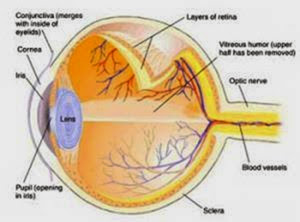nearsightedness See MYOPIA.
night blindness Impaired dark adaptation resulting from slowed photochemical reactions in the rods, the specialized cells of the RETINA that perceive contrast and detect visual images in low light. Night blindness becomes increasingly common after middle age. The person with night blindness may be unable to see at all in dim light or may experience delayed adjustment when going from a lighted environment to a dim or dark environment. A diminished VISUAL FIELD with restricted peripheral vision also contributes to night blindness, as the outer edge of the retina where peripheral vision takes place contains mostly rods.
There are not many treatment options for night blindness. Nutritional supplementation of vitamin A and the antioxidants LUTEIN and ZEAXANTHIN, which some studies show help maintain the health of the eye and improve the functioning of the rods, seem to aid some people. Adequate lighting when reading and especially when watching television or movies reduces the need for the eye to make accommodations for changing light. Increased lighting can compensate for diminished dark adaptation in static settings such as rooms and offices, though it is not possible to make similar accommodations for functions such as driving.
See also AGING, EYE AND VISION CHANGES THAT OCCUR WITH; ANTIOXIDANT; PRESBYOPIA; VISION HEALTH.
nystagmus Involuntary movements of the eyes, usually rapid and repetitive. Nystagmus can be congenital or acquired; in either circumstance it is a symptom of underlying disorders rather than itself a condition. Nystagmus nearly always indicates VISION IMPAIRMENT; if congenital, the impairment may improve or completely resolve with age. Vision impairment in adults depends on the underlying cause of the nystagmus. Temporary induced nystagmus, such as may occur with caloric testing (warm or cool water infused into the auditory canal) to assess disorders of the vestibular system, does not affect vision, although vestibular disorders can cause nystagmus.
 The diagnostic path includes a comprehensive OPHTHALMIC EXAMINATION and NEUROLOGIC EXAMINATION. Treatment targets the underlying cause. Some adults who have acquired nystagmus receive relief from the muscle relaxant medication baclofen (Lioresal), which interrupts NERVE signals from the BRAIN to the muscles that control the eyes. The long-term consequences for vision depend on the cause and duration of the nystagmus. Occasionally nystagmus occurs as an undesired SIDE EFFECT of antiseizure medications, and typically goes away with switching to another medication.
The diagnostic path includes a comprehensive OPHTHALMIC EXAMINATION and NEUROLOGIC EXAMINATION. Treatment targets the underlying cause. Some adults who have acquired nystagmus receive relief from the muscle relaxant medication baclofen (Lioresal), which interrupts NERVE signals from the BRAIN to the muscles that control the eyes. The long-term consequences for vision depend on the cause and duration of the nystagmus. Occasionally nystagmus occurs as an undesired SIDE EFFECT of antiseizure medications, and typically goes away with switching to another medication.
See also BENIGN PAROXYSMAL POSITIONAL VERTIGO (BPPV); DIPLOPIA; MUSCLE RELAXANT MEDICATIONS; PHO- TOPHOBIA; STRABISMUS.

